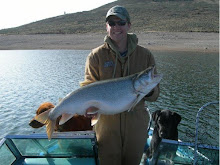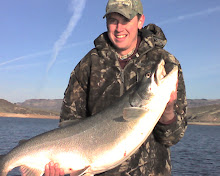Thursday, February 25, 2010
African Safari in New Mexico?
I recently took what some would consider the hunt of a lifetime. I could not argue though I hope to have several "hunts of a lifetime" but this one will no doubt make the list. For those of you that didn't know, in the 1960's New Mexico transplanted some exotic species to the southern part of the state including Gemmsbuck (oryx), Ibex, and Barbary Sheep (Aoudad). All of these animals can now be hunted and are free ranging. That's right, exotic hunts that are not high fence hunts! The tags are hard to come by, but sure worth looking at applying for. I was fortunate enough to draw a February Oryx tag on the Stallion section of the White Sands Missile Range. What a blast!! 55 degree weather in mid winter, plenty of animals and something different than anything I've ever done. If you have never looked at these hunts you need too. The unfortunate thing is that until this year, you only had to submit a $12 application fee to apply. Starting this year all tag fees in New Mexico must be fronted. The upside is the odds should get a lot better, but the downside, obviously, is having to front some serious coin. For those of you thinking about checking out these oryx hunts, don't forget the application period is sooner than the rest of the critters in New Mexico. In fact, the application deadline has already come and gone for this year, Feb 3rd. These hunts are a little different than your conventional hunt in that there is 70 tags given out and they are two day, once in a lifetime hunts, but sure is worth a look if you are interested in experiencing a little bit of Africa just a few miles down the road. Don't let the tag numbers or short season detere you. Most hunts run 70%-80% success rates. Based on my hunt, use your optics and you will see plenty of animals. Get out of your truck and you will lose 80% of the crowd. If you have any questions or would like me to fill out applications for you, check out our website www.weekendwarrioroutdoors.com . Good luck and happy hunting!
How deep do I fish when Ice Fishing?
Probably one of the most common questions I get about Ice fishing is how deep do I fish and where in the water column are the fish? The answer? It depends. Not trying to be a smart alic, but place and depth is different for different species of fish. In general, 90% of the fish I pull through the ice come off the bottom. In fact I often try to bounce my jig off the bottom. As a general rule, stay no more than two reels off the bottom. The exceptions are rainbow's and kokanee.
Kokanee: are almost never on the bottom, in fact the hardest part of finding kokanee is finding the depth. Once you catch one, you can usually catch more by keeping your lure at the same depth. Look to start at 40' of water and move deeper fishing the whole water column as you move.
Rainbows: In my experience the biggest rainbows come from or near the bottom but it is not uncommon to find the fish traveling in suspended water. You may be missing out by not trying different depths. While rainbow's can come from deeper water I would focus on 10-20'
Browns: Browns almost always stay on the bottom. I like to spend 90% of my brown fishing time one crank off the bottom. If you miss a fish, quickly check your bait and put it right back down. More often than not you will get another chance at that fish. More important than depth is structure. Look for rock points and ridge lines that might extend into the water.
Lake Trout: Keep your bait right on the bottom. In fact I like to let my jig rest completely on the bottom for a few seconds every now and then. The jigging motion needs to be slower and a lot more deliberate. Keep in mind that some of the softest bites turn into the biggest fish. The biggest fish I have ever caught through the ice hit so soft that it barely moved the line across the hole with absolutely no downward pressure. Look for flatter spots often in front of bays and coves. Start around 30' and work out up to 60' or more.
The biggest problem unsuccessful fishermen have is being stationary. If the fish aren't biting, MOVE. It is not uncommon for me to move 3, 4, 5 times in the course of a morning. Even if it is only a few yards. Sometimes even a small move will take you out of moss, over a rock pile, out of a rock pile, etc. Even with a hand auger, what does it matter how long it takes to drill a hole if you aren't catching anything anyways. So, drill some holes, have some fun, and enjoy a fresh fish dinner tonight. Ice fishing can be some of the most productive fishing and we still have a few weeks of great fishing left.
Kokanee: are almost never on the bottom, in fact the hardest part of finding kokanee is finding the depth. Once you catch one, you can usually catch more by keeping your lure at the same depth. Look to start at 40' of water and move deeper fishing the whole water column as you move.
Rainbows: In my experience the biggest rainbows come from or near the bottom but it is not uncommon to find the fish traveling in suspended water. You may be missing out by not trying different depths. While rainbow's can come from deeper water I would focus on 10-20'
Browns: Browns almost always stay on the bottom. I like to spend 90% of my brown fishing time one crank off the bottom. If you miss a fish, quickly check your bait and put it right back down. More often than not you will get another chance at that fish. More important than depth is structure. Look for rock points and ridge lines that might extend into the water.
Lake Trout: Keep your bait right on the bottom. In fact I like to let my jig rest completely on the bottom for a few seconds every now and then. The jigging motion needs to be slower and a lot more deliberate. Keep in mind that some of the softest bites turn into the biggest fish. The biggest fish I have ever caught through the ice hit so soft that it barely moved the line across the hole with absolutely no downward pressure. Look for flatter spots often in front of bays and coves. Start around 30' and work out up to 60' or more.
The biggest problem unsuccessful fishermen have is being stationary. If the fish aren't biting, MOVE. It is not uncommon for me to move 3, 4, 5 times in the course of a morning. Even if it is only a few yards. Sometimes even a small move will take you out of moss, over a rock pile, out of a rock pile, etc. Even with a hand auger, what does it matter how long it takes to drill a hole if you aren't catching anything anyways. So, drill some holes, have some fun, and enjoy a fresh fish dinner tonight. Ice fishing can be some of the most productive fishing and we still have a few weeks of great fishing left.
Labels:
blue mesa,
brown trout,
fishing,
ice fishing,
lake trout
Subscribe to:
Comments (Atom)





